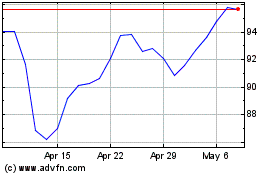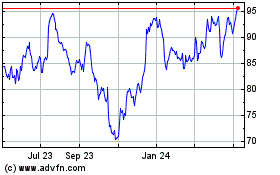Morgan Stanley Posts Biggest Fourth-Quarter Profit Since Crisis -- 3rd Update
January 17 2017 - 8:25AM
Dow Jones News
By Liz Hoffman
Morgan Stanley posted its best fourth quarter since the
financial crisis, handily beating analyst expectations as all of
its major businesses generated higher revenue.
The New York-based firm reported a profit of $1.67 billion, or
81 cents a share, in a quarter that included a surge of
postelection trading activity.
That compares with the $908 million, or 39 cents a share, it
reported in the same period a year earlier.
It is the bank's highest profit in any fourth quarter since
2006. Morgan Stanley has tended to struggle toward year-end and has
lost money two of the past five fourth quarters, in part due to
legal set-asides that are now largely behind it.
Those legal issues are now mostly behind the bank, which has
also improved in trouble spots like debt trading. That said,
profitability is still below a key target set by Chief Executive
James Gorman.
Revenue in the fourth quarter grew 17% to $9.02 billion from
$7.74 billion a year earlier. Analysts polled by Thomson Reuters
had expected revenue of $8.47 billion and earnings of 65 cents a
share.
The firm's return on equity, a closely watched measure of
profitability, was 8% for the year. That was up from 7.8% in 2015,
including accounting adjustments, but still short of the 10% target
laid out by Mr. Gorman.
Many big banks have struggled to beat that yardstick since the
financial crisis. But Mr. Gorman, CEO since 2010, has made clearing
it a central goal for the bank -- one his job may hinge on.
Morgan Stanley shares rose 1.4% premarket. They have gained 28%
since the election, which sent financial stocks soaring on investor
hopes of lighter regulation.
Morgan Stanley faced high expectations following fairly strong
earnings from rivals J.P. Morgan Chase & Co. and Bank of
America Corp. last week that AllianceBernstein analyst John
McDonald called "good enough to keep the dream alive."
A flurry of postelection stock trading boded well for Morgan
Stanley, Wall Street's leading equities-trading house.
Revenue in that division, which trades stocks and stock-linked
instruments, rose 7.4% to $1.95 billion from $1.82 billion a year
ago, while debt-trading revenue -- a weaker spot for Morgan Stanley
-- nearly tripled to $1.47 billion from $550 million a year
earlier. Total sales and trading revenue grew to $3.19 billion from
$2.37 billion in the year-earlier period, including accounting
adjustments.
Investment-banking revenue, which includes merger advisory and
underwriting fees, rose 4.9% to $1.27 billion from $1.21 billion in
the fourth quarter of 2015.
Fees from corporate mergers fell 17%. Along with rivals, Morgan
Stanley, the No. 2 M&A adviser last year, faces a tough
comparison with 2015 when merger activity set a record as chief
executives scrambled for growth.
In wealth management, where Mr. Gorman has steered Morgan
Stanley in search of stabler profits and less regulatory scrutiny,
revenue rose 6.4% to $3.99 billion from $3.75 billion a year
earlier. The unit's profit margin was 22%, down from 23% last
quarter and within the range Mr. Gorman has targeted.
Advising Americans on their retirement and managing their
investments now accounts for about half of Morgan Stanley's revenue
-- once unthinkable for a firm that clung to its investment-banking
roots. Fees from these businesses don't swing as much with the
market and receive less scrutiny from regulators.
But they are less profitable than, say, investment banking,
where margins can approach 50%. Wealth advisers keep a larger haul
of the revenue they bring in than bankers or traders.
Morgan Stanley's compensation ratio was 46% for the year,
compared with 47% last year. Overall annual expenses fell 3.3% as
Mr. Gorman seeks to make good on his promise to trim $1 billion in
costs, assuming flat revenue.
Investment-management revenue fell 19% to $500 million and its
pretax profit margin fell to single digits. That division, Morgan
Stanley's smallest, manages money for other asset managers, pension
funds and corporations. It has grappled with a shift toward passive
investing and new regulations affecting money-market funds.
Write to Liz Hoffman at liz.hoffman@wsj.com
(END) Dow Jones Newswires
January 17, 2017 08:10 ET (13:10 GMT)
Copyright (c) 2017 Dow Jones & Company, Inc.
Morgan Stanley (NYSE:MS)
Historical Stock Chart
From Mar 2024 to Apr 2024

Morgan Stanley (NYSE:MS)
Historical Stock Chart
From Apr 2023 to Apr 2024
